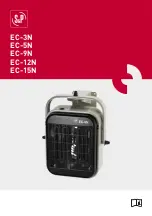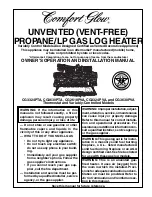
CONNECTIONS – PLUMBING
43
TEMPERATURE PRESSURE RELIEF VALVE
The temperature pressure relief valve is shipped in a plastic bag attached to the side of water heater. The
temperature pressure relief valve must be fitted before the water heater is operated. Before fitting the relief
valve, make sure the probe has not been bent.
To fit the relief valve:
•
Seal the thread with an approved thread sealant such as Teflon tape - never hemp. Make sure tape does
not hang over the end of the thread.
•
Hand tighten the valve into the opening marked “Relief Valve” (refer to the
page 40).
•
Using a spanner engaged on the v
alve’s spanner flats and applying medium pressure to tighten, turn the
relief valve an additional ½ to 1 ½ turns to secure and make the joint water tight, leaving the valve drain
pointing downwards.
Warning:
Do not use a pipe wrench or poor fitting tool on the valve body nor over tighten the valve,
as this could damage the valve and prevent safe operation.
•
Operate the easing lever on the valve to check the smooth operation of the valve plunger. It is very
important the lever is raised and lowered gently. The lever should move smoothly and without undue force.
•
If the lever cannot be moved or is jerky in its movement, then the valve has been damaged and must be
replaced.
•
A copper drain line must be fitted to the temperature pressure relief valve (refer to
page 43).
•
The valve must be insulated with closed cell polymer insulation or similar (minimum thickness 9 mm) and
the insulation installed so as not to impede the operation of the valve.
The insulation must be weatherproof and UV resistant if exposed.
EXPANSION CONTROL VALVE
Local regulations may make it mandatory to install an expansion control valve (ECV) in the cold water line to
the water heater. In other areas, an ECV is required if the saturation index is greater than +0.4 (refer to
on page 30).
The expansion control valve must always be installed after the non-return valve and be the last valve installed
prior to the water heater
. A copper drain line must be fitted to the expansion
control valve (refer to
on page 43).
The valve, if installed within 500 mm of the water heater, must be insulated with closed cell polymer insulation
or similar (minimum thickness 9 mm) and the insulation installed so as not to impede the operation of the valve.
The insulation must be weatherproof and UV resistant if exposed.
RELIEF VALVE DRAIN
DN15 copper drain lines must be fitted to the temperature pressure relief valve and expansion control valve (if
one is installed) to carry the discharge clear of the water heater. Connect the drain lines to the valves using
disconnection unions. The drain line from the valve to the point of discharge should be as short as possible,
have a continuous fall all the way from the water heater to the discharge outlet and have no tap, valves or
other restrictions in the pipe work.
A drain line from a relief valve must comply with the requirements of AS/NZS 3500.4.
A drain line must be no longer than 9 metres with no more than three bends greater than 45° before discharging
at an outlet or air break. The maximum length of 9 metres for a drain line is reduced by 1 metre for each
additional bend required of greater than 45°, up to a maximum of three additional bends. Where the distance
to the point of final discharge exceeds this length, the drain line can discharge into a tundish.
Subject to local regulatory authority approval, the drain lines from the temperature pressure relief valve and
expansion control valve from an individual water heater may be interconnected.
Содержание 270HAV
Страница 40: ...INSTALLATION 40 TYPICAL INSTALLATON OUTDOOR LOCATION ...
Страница 50: ...50 This page is intentionally blank ...
Страница 51: ...51 This page is intentionally blank ...










































